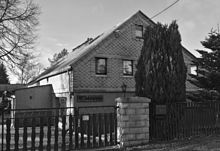Adolphus Stolln
Adolphus is the name of a tunnel and a treasure trove in the Johanngeorgenstadt mountain area in the Saxon Ore Mountains .
location
The mouth of Adolphus Stolln was on the middle Fastenberg between Eibenstocker Strasse and Robert-Koch-Strasse. The overgrown heap was also referred to as a beehive because beekeeping was carried out there before the Second World War.
The treasure trove was located above the sulfur pond and the Archangel area.
The former hat house with the lettering Adolphus is on Käthe-Kollwitz-Straße. A dump has also been preserved. Halde and Huthaus originally belonged to the Elisabeth Tagschacht .
history
Adolphus treasure trove
Adolphus Stolln
The Adolphus Stolln was muted in the quarter of Trinity 1707 , after having previously struck gold in the Catharina treasure trove . The adit was m NN struck at 796 and in the central mountain almost to the so-called Erzengler Mountains propelled while u. a. the treasure trove of Silberkammer , Gotthelf Schaller , Catharina , Elisabeth , the Holy Three Kings and the Lorenz brothers solved. By cutting the tunnel, the tunnel produced 65 kg of silver by 1722. In 1763, the city Johanngeorgenstadt let the Stoll water for some time the drinking water supply of the city served by the mining authorities give . A clause stated that the city was only allowed to use the water as long as it was not needed for mining. Until 1833, the gallery was operated by the pits Eleonore Erbstolln and Adolphus Fundgrube together with Archangel Gabriel Maaßen . After the adit was closed, the city assumed the Adolphus Stollnwasser on August 14, 1833 . The courage was linked to the duty to maintain the tunnel. From 1853, the tunnel was kept by the Adolphus Fundgrube , Vereinigt Feld im Fastenberge and by the municipality in terms of time limits . Contrary to legal regulations, no mining work had to be carried out to meet the deadline, only repair work. 1845 began workover of Adolphus treasure trove by a union. The mine operation lasted until 1894, after which the mine was on schedule until 1900. In May 1901 a new trade union resumed operation of the treasure trove. There was an agreement with the city that a safety distance of 10 m from the tunnel is maintained. To secure the water supply, the city assumed a 12.5 hectare large pit field between Adolphus , Treuefreundschaft and United Field . On July 27, 1899, the lending certificate was issued under the name Johanngeorgenstädter Ratsstolln . Since no ore mining was intended, the mining authority had to extend the deadline for the mine field every 2 years. After a breach had been worked through in 1888, after 1900 further parts of the tunnel were worked through in order to make further amounts of water usable. The Erzengler Tagschacht was reached on December 17, 1910 . The westernmost point of the tunnel field was the mine field of Archfather Jacob in the area of the later bismuth shaft 121. The total length of the tunnel was approx. 4.5 km. In order to secure the minefield of the Adolphus Fundgrube permanently, the city bought 85.5 of 106 Kuxen of the Fundgrube on January 30, 1922. In 1929 the city received another six Kuxe gifts. The mining operation had been inactive since 1921 and the mine was on time. Since the mining work was not resumed, the Mining Authority had to extend the deadline every two years. When the Gotthelf Schaller Tagschacht broke, part of the pit water in the Brothers Lorenz Schacht collapsed onto God's grace tunnel . In 1934 the tunnel wing to the Gotthelf Schaller shaft was therefore cleared. In 1935, the wing of the Three Kings Day shaft was also opened. As part of the self-sufficiency drive of the German Reich , the law for the development of mineral resources was passed in 1936. As a result, the Mining Authority no longer extended from December 31, 1936 and put the city administration under pressure either to start mining or to give up the mining rights. The aim was to enable the Adolphus treasure trove to be taken over by the Consolidated Union of United Field in Fastenberge following the fall into Bergfrei . The dispute that ensued between the Johanngeorgenstadt administration and the Oberbergamt was not ended by the end of the war. Since the documents were destroyed during the war, the Mining Authority requested documents from the city administration on November 23, 1946 to clarify the problem. A decision there was no more, because of the acquisition of mining concessions by the object 01 of the bismuth AG and the mining concessions of Stollns were affected in the 1946th Deprived of its foundation, the Adolphus Fundgrube company went into liquidation on November 4, 1947 , but it was not completed until 1951. The Bismut used old shafts in the area, Brothers Lorenz ( shaft 60 ), Adolphus Tagschacht (shaft 119) and Archangel and dug new shafts (shaft 32 and 39). These shafts were connected to the tunnel. Nevertheless, the tunnel served the city's drinking water supply until 1949. After mining ceased in 1951, the gallery lost its importance. The mouth hole is leveled today.
swell
literature
- Frank Teller : ABC of the Johanngeorgenstadt mines . In: Nachrichtenblatt and Anzeiger for Johanngeorgenstadt and the surrounding area 1993.
- Frank Teller: Mining and mining town Johanngeorgenstadt . Förderverein Pferdegöpel Johanngeorgenstadt eV, Johanngeorgenstadt 2001.
- Frank Teller: change, change, change . Förderverein Pferdegöpel Johanngeorgenstadt eV, Johanngeorgenstadt 2009.
Individual evidence
- ↑ Johann Christian Engelschall : Description of the exiles and mountain town Johann Georgen city . Friedrich Lanckischen's heirs and Christoph Kircheisen, Leipzig 1723, p. 231 .
Coordinates: 50 ° 26 ′ 7.5 ″ N , 12 ° 42 ′ 51.1 ″ E
